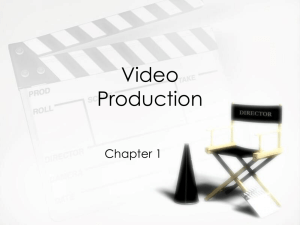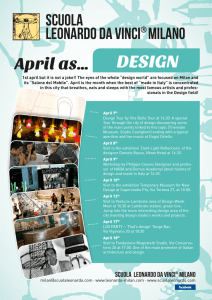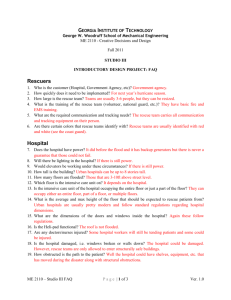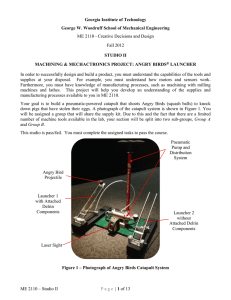i) A completed Design Objectives Tree. - Singhose
advertisement
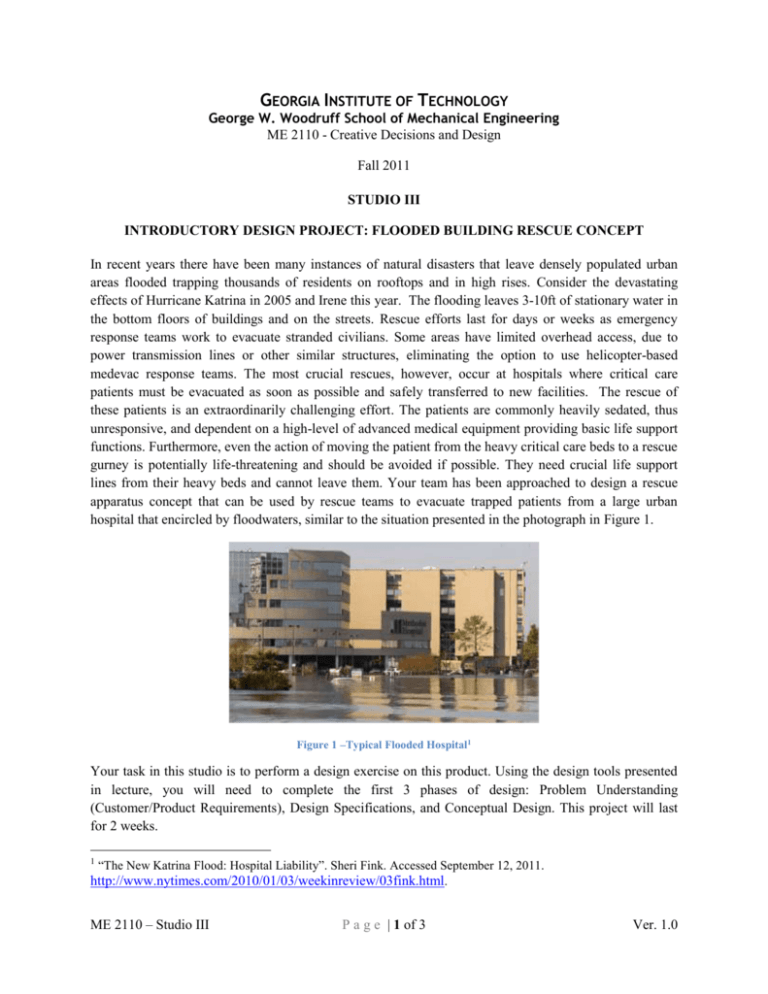
GEORGIA INSTITUTE OF TECHNOLOGY George W. Woodruff School of Mechanical Engineering ME 2110 - Creative Decisions and Design Fall 2011 STUDIO III INTRODUCTORY DESIGN PROJECT: FLOODED BUILDING RESCUE CONCEPT In recent years there have been many instances of natural disasters that leave densely populated urban areas flooded trapping thousands of residents on rooftops and in high rises. Consider the devastating effects of Hurricane Katrina in 2005 and Irene this year. The flooding leaves 3-10ft of stationary water in the bottom floors of buildings and on the streets. Rescue efforts last for days or weeks as emergency response teams work to evacuate stranded civilians. Some areas have limited overhead access, due to power transmission lines or other similar structures, eliminating the option to use helicopter-based medevac response teams. The most crucial rescues, however, occur at hospitals where critical care patients must be evacuated as soon as possible and safely transferred to new facilities. The rescue of these patients is an extraordinarily challenging effort. The patients are commonly heavily sedated, thus unresponsive, and dependent on a high-level of advanced medical equipment providing basic life support functions. Furthermore, even the action of moving the patient from the heavy critical care beds to a rescue gurney is potentially life-threatening and should be avoided if possible. They need crucial life support lines from their heavy beds and cannot leave them. Your team has been approached to design a rescue apparatus concept that can be used by rescue teams to evacuate trapped patients from a large urban hospital that encircled by floodwaters, similar to the situation presented in the photograph in Figure 1. Figure 1 –Typical Flooded Hospital1 Your task in this studio is to perform a design exercise on this product. Using the design tools presented in lecture, you will need to complete the first 3 phases of design: Problem Understanding (Customer/Product Requirements), Design Specifications, and Conceptual Design. This project will last for 2 weeks. 1 “The New Katrina Flood: Hospital Liability”. Sheri Fink. Accessed September 12, 2011. http://www.nytimes.com/2010/01/03/weekinreview/03fink.html. ME 2110 – Studio III P a g e | 1 of 3 Ver. 1.0 1) Deliverables due by the end of this studio (week of 12 September) i) A completed Design Objectives Tree. The team must show a preliminary understanding of the design problem by creating a Design Objectives Tree (DT1). This can be completed by hand. The team will informally present this to the Instructor by the end of the lab in order to discuss and revise your customer requirements and design objectives. ii) A list of questions that the team would like to ask the customer about what is wanted in the design. (1 page) In design, you sometimes have the option to present your problem understanding to the customer to verify that you are in agreement with what is wanted. This is your opportunity to ask questions. By the end of lab, your team needs to email your TA a list of questions about the design that you would like the customer to answer. Each team is allowed up to 1 page of typed questions (12pt font). A FAQ sheet with pertinent question answers will be added to the course website by 4:00 p.m. EST Friday, September 16th. The design concepts considered in your design should incorporate any additional understanding provided in the answers to all the questions in the FAQ. 2) Deliverables due at the beginning of studio next week (week of 19 September) i) A technical presentation of problem understanding and five (5) preliminary design ideas. (In PowerPoint, limited to 7 min.) Clearly describe the design Problem Understanding that the team has generated. Present a House of Quality and explain how it has aided your understanding and what insight is has given your team. Present a review of products currently on the market and discuss their strengths and weaknesses. List any applicable patents that may limit or influence the team’s design project. (Any pictures/videos obtained from the internet must have the corresponding source clearly indicated.) Present the design specifications while highlighting the most crucial ones. Present a function tree that the design must execute. Show a morphological chart and point out the most promising design ideas. Then, clearly describe the functionality of your preliminary designs. The designs should be distinct from each other. A change in color or size is not sufficient to qualify as a distinct alternative design. The presentation will be given by a single member of the team who you nominate. Review the posted lecture notes regarding technical presentation. This presentation has a large amount of content but only limited presentation time. Each slide should be thoroughly planned out to maximize presentation efficiency. ii) A written document containing: a) A list of all the available products that the team located. Give the product name, company, price, and cite the source of product information. Put this list in an Excel document and email this list to your TA. b) A list of relevant patents. Give the patent number, title and inventor. ME 2110 – Studio III P a g e | 2 of 3 Ver. 1.0 3) Deliverables due at the beginning of studio in two weeks (week of 26 September) i) A presentation on the team’s final design (In PowerPoint: 5 min.) ii) A completed peer evaluation form for this studio team iii) Two (2) hard copies and one (1) electronic (PDF) copy of a final report containing the following: 1) Title Page 2) Abstract Standalone summary of this report’s contents 3) Introduction Define the customer’s needs\wants\desires and the overall product function. 4) Design Objectives Include succinct presentation of the problem understanding process followed and results from problem analysis: House of Quality Function Tree Specification List 5) Design Overview Give a detailed description of the final design including quality CAD-generated figures that show its components and how it operates. 6) A Discussion that presents: Four alternative design solution ideas. (That means 5 total designs). Written explanation of why you chose your design from among the five considered designs. Use a structured evaluation process. Explanation of the advantages and disadvantages of your chosen design. 7) Conclusion Conclusions that this report has reached including the expected design specifications and what components need more extensive detailed design The report should include a maximum of seven (7) pages of writing, plus as many figures and tables as necessary. The report should adhere to the format requirements detailed below: Times New Roman typeface 12pt font 1.5 line spacing 1.0” page margins Figures, tables, citations after the complete body of text including appendices Review the lecture notes regarding report writing. Email a PDF copy of this report to your section TA and submit 2 printed copies of this report at the beginning of studio. ME 2110 – Studio III P a g e | 3 of 3 Ver. 1.0




